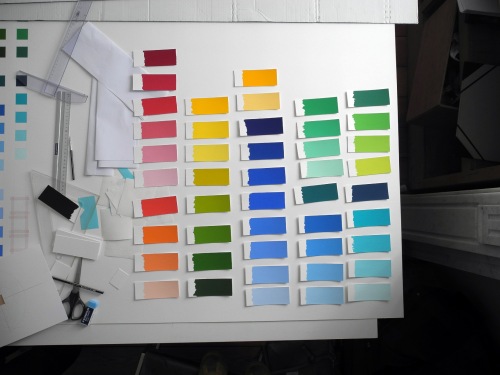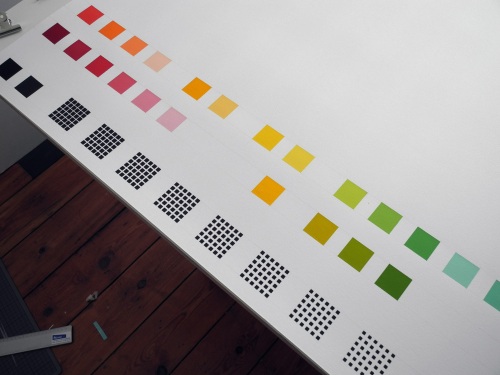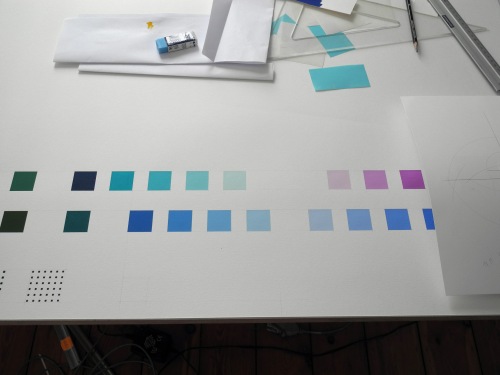CLICK ON THE PICTURES TO ZOOM ON ‘EM!
I still have to measure the colors I made from pure and mixed pigments here to be sure and more precise about that, but a priori I would estimate that about half of them are either badly rendered by the digital camera, or simply un-displayable on a standard computer screen (outside the sRGB gamut!)
The 41 colors I did so far are an attempt to get very close to ‘MacAdam’s limits,’ i.e., the best colors that can be made from pigments or other colored materials without ‘cheating’ with fluorescence (anyway fluo or ‘neon’ colors are fugitive, and another constraint of the colors made here is lightfastness… only highly lightfast pigments are used.)
Pigments are: Ultramarine Blue (Greenish,) 5 types of Phtalocyanines: Reddish-Blue, Cyan, Blue-Green and 2 Greens; Cadmium: Red, Red-Orange, Orange and 4 Yellow types; PR122 Sennelier & Lukas; Cobalt: Turquoise Brilliant & Dark, Pink; Lamp Black; Titanium & Zinc Whites.
Some colors might look like blacks while they are extremely saturated & dark colors (my darkest color is actually a Blue, not a Black! Its reflectance adds up to 2.6%!)
Next update I’ll clarify what’s possible to display on a screen (tomorrow probably.)
Bye ;)





4 responses to “Primaries again (D65 n°4)”
Hi. Do you have any tips on mixing colors close to the MacAdam limit, or what are good pigments to use for this? I am interested in doing this, especially for super saturated reds and violets (near the corners of the CIE color space, so obviously dark colors), and a super light but still very saturated yellow.
Hi David! What kind of binder are you using? It usually works well to mix a mineral basis close to your target (e.g. Cadmium Red light) with a transparent “corrector” (PR122 Magenta). This works with blue (PB29+PB15), violet (PB29+PR122) green (PG7+PY74, or cadmium yellow if you prefer).
For the yellow, there’s not much that can be done, you have great stuff available in the cadmium pigments and the organic ones (PY74 is beautiful for ex. But not super lightfast). However you could try to mix tartrazine Yellow (transparent) with Bismuth-Vanadate of Cadmium Yellow to see if it purifies the result…
Can you send me a link to your work?
Thanks a lot for the tips! I work almost entirely in acrylics, and I’ve used the GAFA paints before. I will try out your suggestions. My blog is https://www.althaipaints.net/ if you want to take a look at my work.
You should also simply try pyrrole red + cadmium red or PR122… Just remember this simple rule to get close to MacAdam’s limits: (1) you get as close as possible with an opaque pigment that is already as LIGHT and as SATURATED as possible (2) you correct the spectrum by SUBTRACTING the part you want to get rid of with a pigment that is as TRANSPARENT as possible – usually “process colors” are the best to start with (3) if you are not satisfied, you can try the nuances of the process colors: for magenta the basic one is PR122, but you also have a bunch of PV19 that are interesting, or transparent pyrrole red. For Cyan, you have the basic PB15, but also PB15:2, 15:3, etc. and PB16 for turquoise, PG7 for green PG36 yellow greenish… You may not find everything in there, but Golden fluid colors are good stuff if you use acrylic. However, you can go a bit beyond with Gouache… But then it is better to do the colors by yourself (there is often some shit in the available gouaches…), I’d advice fish glue+water+drops of ethanol. If you want a super black, buy iron-manganese spinel black